14 April 2022
Originally published
01 February 2022
Source
Aleksandar Petrović comes from a Serbian family, Dennis Miskić from a bosnian family. Together, the two young men are the first Austrians who do their community service in Srebrenica.
The cemetery of Potočari in the eastern Bosnian municipality of Srebrenica is covered with frost and mud. Dennis Miskić and Aleksandar Petrović, two young Viennese, trudge along the rows of white marble steles, a sludge of damp earth and blades of grass sticking to their shoes. They have been tasked with photographing each of the graves with Muslim names on them from three different angles: around 20,000 shots in total. “My stomach turns every time I’m here,” says Miskić. “It’s an uneasy feeling working next to a mass grave”, adds Petrović. After weeks of work, they are shooting the last pictures – just in time before winter buries the cemetery under a blanket of snow that will last until spring. The young men’s photos will be used to create a 3D animated database of all the gravestones, making it easier to locate and access information on those buried here. Nearby, a lone watchtower weathers like a memorial. The letters on it spell “UN”, United Nations.
Under the eyes of Dutch peacekeepers, a war crime occurred in the heart of Europe between 11 and 22 July 1995. Led by Bosnian Serb general Ratko Mladić, soldiers of the army of Republika Srpska, along with Bosnian Serb police officers and Serb paramilitaries, killed more than 8,000 Bosniak boys and men in the UN protection zone of Srebrenica. At the time of the systematically planned genocide of Bosnian Muslims, Dennis Miskić and Aleksandar Petrović’s parents, who lived a fifty-minute flight away from the massacre in safe Vienna, were still planning their weddings. Miskić’s parents are from Bosnia-Herzegovina and had barely escaped the war in their homeland, while Petrović’s parents arrived as guestworkers much earlier, in the 1980s, from Serbia, then still part of Yugoslavia. The respective couples met for the first time in the Austrian capital and fell in love. A few weeks after the events in Srebrenica, they two couples got married. Dennis and Aleksandar were not born until years later.
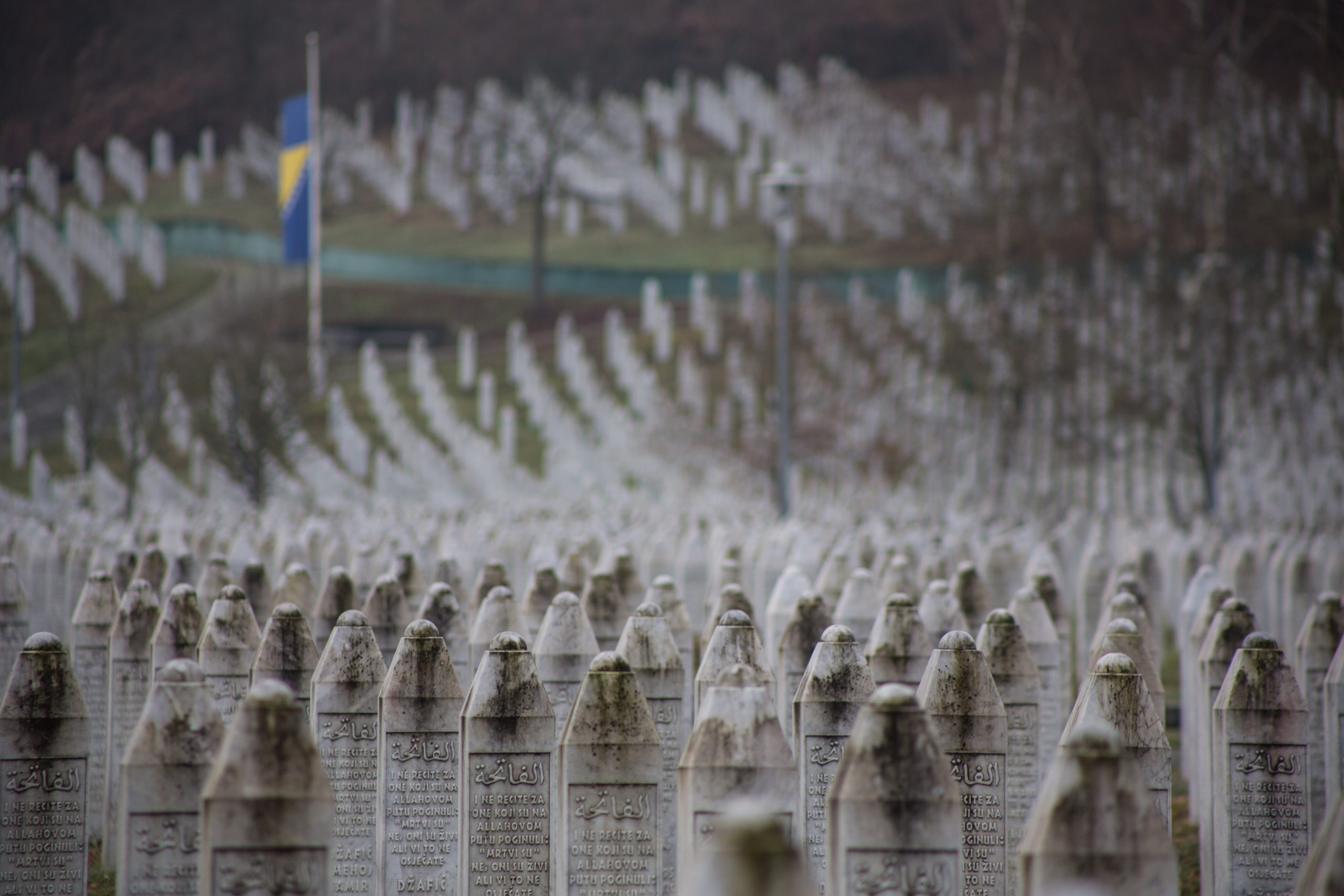
The Srebrenica-Potočari Memorial Center for the Victims of the 1995 Genocide was established in 2000 by the decision of the High Representative for Bosnia and Herzegovina. Each year the Day of Remembrance takes place on 11 July. Photo: Martin Zinggl / tippingpoint.net
While their home countries waged war with each other, the two boys’ parents lived in neighbouring districts in Vienna. Separated only by the Danube, they would nevertheless never get to know each other – nor would they return to the Balkans to settle. Their sons, however, will.
In October 2021, more than a quarter of a century after the war crimes in Srebrenica, Miskić, now 19 years old, and Petrović, 23, place their valuables in a dark plastic tray and step through the security gate into the Vienna Ministry of Justice. Their stomachs are churning, their faces red, their hands sweating, their foreheads wet. The young men are nervous because Minister of Justice Alma Zadić is receiving them to give them an official send-off. Zadić, herself a native Bosnian, is known for inviting young people to the ministry, especially when there is a connection between former Yugoslavia and Austria. Miskić and Petrović will complete their national service, known as peace service, in Bosnia-Herzegovina. For the first time in the history of the sending organisation, Austrian Service Abroad, volunteers will travel to Potočari, less than ten kilometres from Srebrenica, where a memorial center was set up next to the cemetery in 2003 to impart knowledge and history.
This state institution houses an archive of memorabilia of those killed, including photos, videos and thousands of hours of documented interviews. It aims to reappraise the events of July 1995 and their aftermath through exhibitions to bring to mind the horror and its victims – and the hesitation of the international community. Miskić invested one and a half years of preparation, writing hundreds of e-mails to the relevant authorities, before his assignment abroad was approved. Shortly afterwards, Petrović followed his colleague’s initiative. Over a period of five months, they will be the first peace servants from abroad to support the Memorial Center and be involved in the projects: interviewing the survivors, transcribing and translating documents, photographing gravestones, preparing exhibitions, and trying to retrieve the facts from history. Following this stint, the second part of their assignment will take them to Dayton in the US for another five months.
„Being in Bosnia for so long, away from home for the first time, even more so as a Serb. I’m skating on thin ice there.“
Dayton is the place where in November 1995 the Dayton Peace Agreement officially ended three and a half years of lynching, rape and destruction and led to the creation of the state of Bosnia and Herzegovina. It’s the place where Bill Clinton, Jacques Chirac and Helmut Kohl boasted that they had acted in the country’s best interest in dividing the small state into two semi-autonomous entities, whose complex structure has a stranglehold on society and politics to this day. The majority of Bosnian Serbs have lived in the “Republika Srpska” ever since, while the “Federation” is mainly home to Bosnian Croats and Bosniaks. Srebrenica and the memorial site in Potočari are located in the very east of the Republika Srpska, less than fifteen kilometres from Bosnia and Herzegovina’s border with Serbia.
A place without a future
Once known for its silver and zinc mines, Srebrenica was also a popular health resort, attracting Yugoslavs from all parts of the multi-ethnic state: a prosperous small town in a community of 40,000 inhabitants, the majority of whom were Bosniaks. Then nationalism addled the minds of the inhabitants, led to war and culminated in the genocide for which Srebrenica gained notoriety. After the war, life lay dormant. Few returned; today the city has less than 5,000 people. The place has no future but an almost unbearable past. Everyone knows everyone here, which is why the victims know the perpetrators and vice versa.
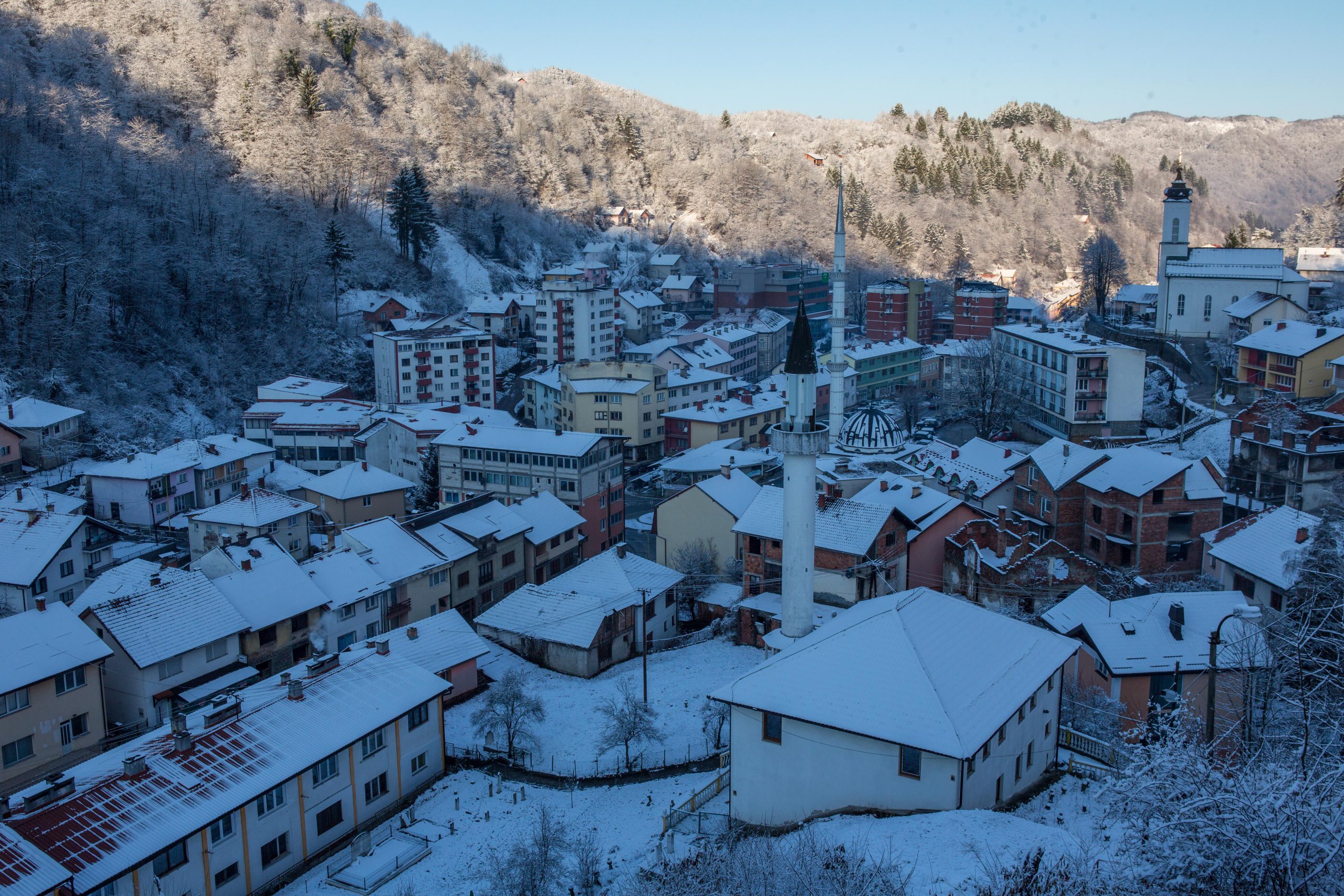
Many fled their homes forever during the war. What remained is the almost unbearable past. Today, the once prosperous mining town of Srebrenica has less than 5,000 people. There is also nothing left from the glamour of the former and popular health resort. Photo: Martin Zinggl / tippingpoint.net
Few places in Bosnia-Herzegovina are as burdened with their history and location as Srebrenica or have caused more uproar among neighbours, who once visited each other without even knocking and then turned on each other. Miskić and Petrović are aware of the explosive nature of their chosen place of assignment and that of the memorial site, whose more than seventy employees are composed of survivors and relatives of victims. The fact that the roots of the two young men from Vienna reach back to the former Yugoslavia does not necessarily make the task easier, especially for Petrović.
“This is a huge task for me,” he tells Justice Minister Zadić. “Being in Bosnia for so long, away from home for the first time, even more so as a Serb. I’m skating on thin ice there.” Zadić answers: “I think it’s great that you take up this challenge and I admire your courage.” “I want to be an idol like you, Madam Minister,” says Petrović.“
“Do you have some advice for us, Minister?” Miskić asks. “Listening to the first-hand stories of survivors and relatives on the ground, you suddenly get a different impression than that suggested by friends and family,” Zadić answers. “The overall perspective is important because it contributes to gaining a clearer picture of the past.”
Attentively, the two young gentlemen in suits sit opposite her like pupils taking an important exam. The two did not know each other before the service abroad. They could not be more different and yet they pursue the same goal: to contribute to international understanding, even though their motives differ.
„Listening to the first-hand stories of survivors and relatives on the ground, you suddenly get a different impression than that suggested by friends and family“
His curly hair bundled up in a voluminous man-bun, Miskić has a full beard and rings in his ears and on his fingers. He is self-confident, communicative, bubbles with verve and energy, and his eyes show his curiosity. He’s someone who likes to get to the bottom of things, an extrovert, a bon vivant who knows he cannot change the world, but at least takes a step in a good direction.
Petrović suffers from hair loss due to an autoimmune condition. Sparse stubble sprouts from his chin and above his lips. Glasses protect his gentle eyes. He is pensive, quiet and highly sensitive: a musician, an ascetic, a dreamer who would like all people whose surnames end in -ić drink beer together in peace. He’s just finished a peace hymn. “Our parents taught us to hate our neighbours with whom they used to drink coffee in the past. We behave like enemies, but secretly we love each other,” Petrović raps in it.
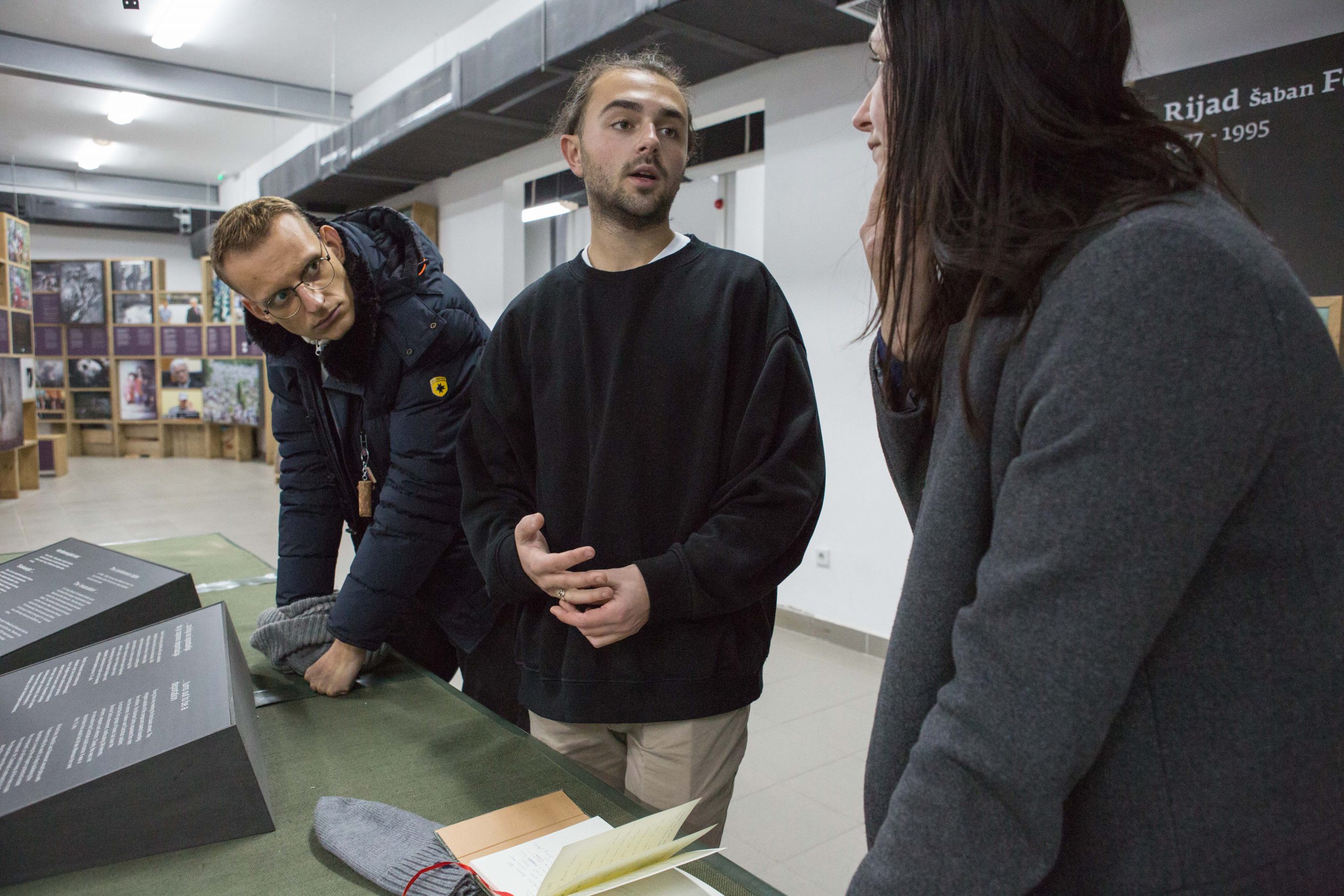
Aleksandar Petrović and Dennis Miskić at the Memorial Center. The two did not know each other before the service abroad. They could not be more different and yet they pursue the same goal: to contribute to international understanding, even though their motives differ. Photo: Martin Zinggl / tippingpoint.net
What do the two peace servants have in common? Neither is fluent in their closely related mother tongues, Bosnian and Serbian. Both know the Balkans only from their annual visits during holidays, and the war of the 1990s only from stories and social media. Both are unencumbered by the past, in that they are non-political and non-religious. Both want to help give a clearer picture of the genocide.
You have to find a balance
This help is truly needed, as, 26 years after the end of the war, the peace construct of the two entities forced to coexist begins to waver. The Dayton Agreement is being put to the test by newly fuelled nationalism, and the country’s stability is threatened. These tensions, however, no longer simmer below the surface, but dominate the political stage and affect everyday life. The one who screams the loudest is the Serbian member of Bosnia-Herzegovina’s tripartite state presidency, Milorad Dodik. The leader of the Bosnian Serb party SNSD boycotts the parliament in Sarajevo, threatening to separate Republika Srpska from the Bosnian central government. He wants to create his own army, a separate tax and judicial system and a separate constitution. It is a step towards seceding from Bosnia-Herzegovina, with Dodik always keeping an eye on joining neighbouring Serbia. There, right-wing conservative president Aleksandar Vučić is vociferously keeping alive the former dream of an ethnically pure Greater Serbia. If Dodik is to be believed, the withdrawal should be completed in six months.
What’s more, Dodik recently drew attention to himself when he publicly denied the genocide in Srebrenica. Such statements were criminalised in Bosnia-Herzegovina in July 2021 on the initiative of the high representative, the country’s highest international diplomatic authority, who has guaranteed peaceful coexistence since Dayton. After twelve years in office, on the last day before handing over to his successor Christian Schmidt, Austrian Valentin Inzko passed this law that many survivors and bereaved families would have wished for two decades ago. Genocide denial is now punishable by up to five years in prison. And the law is already beginning to take effect, as the Memorial Center states in its press reviews. While relevant media have since refrained from publishing denials and hate speech, the political leader of the Bosnian Serbs continues to refuse to call the massacre in Srebrenica a genocide and demonstratively smiles into the cameras: “So arrest me!”
„I’m afraid of having to tell my children about the second Bosnian war 30 years from now. To prevent that from happening, the Serbs are not the only ones who need to do something. Bosniaks must also do their part.“
“Just as there are Serbs who deny the genocide, some Bosnians misuse Srebrenica to channel their hatred of Serbs,” says Petrović after two months of peace service in Srebrenica. Miskić, too, knows about the prejudices and nationalist narratives that are still passed on in many families today, even in the diaspora. “I’m afraid of having to tell my children about the second Bosnian war 30 years from now. To prevent that from happening, the Serbs are not the only ones who need to do something. Bosniaks must also do their part,” he says.“
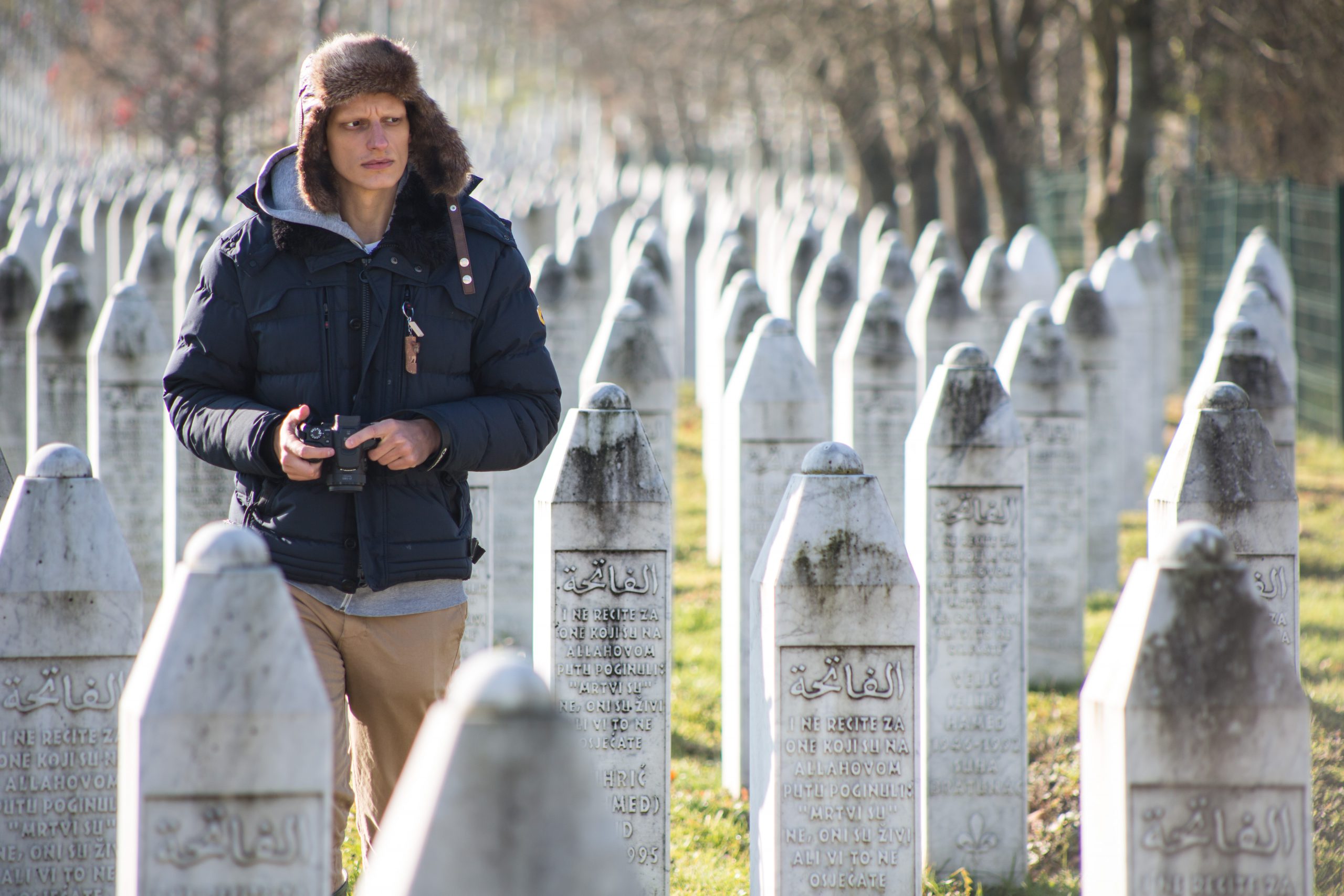
The Memorial Center and its peace servants try to set an example what it means to build bridges. In all of these years, the center has not received a single Serbian application for the publicly advertised positions. Amra Begić is “very happy that young people are getting involved here, especially from the diaspora. Photo: Martin Zinggl / tippingpoint.net
“No one here wants war, but then no one wanted that in the nineties either. It doesn’t take much to reopen old wounds.” The voice of reason is deep and smoky. It belongs to Amra Begić, deputy director of the Memorial Center in Potočari and supervisor of the two Austrian peace servants. She is concerned about the future of Bosnia-Herzegovina. The 43-year-old Bosniak knows first-hand that there is potential for violence and thoughts of revenge – and hence also a need for the Memorial Center and the peace service. At the age of 16, Begić survived the genocide in her hometown of Srebrenica and lost 28 members of her family, including her father and grandfather. She fled, studied criminal science and law in Sarajevo, and only returned in 2005 to work for the Memorial Center. Since then she has met the man who handed her father over to his tormentors almost every day: a Serb – one of many who were involved in war crimes but have not been prosecuted. A question Begić often asks herself when she runs into this or other perpetrators: Would they do it again? “You have to find a balance and get used to living in the same place, but the burden you need to carry here is even heavier than anywhere else,” she says.“
„It doesn’t take much to reopen old wounds. You have to find a balance and get used to living in the same place, but the burden you need to carry here is even heavier than anywhere else.“
Is it possible for a society to ever function again with such atrocities standing between people? Can the separation of “us” and “them” be overcome? Begić tells of a young man, much too young to have taken part in the massacre. Having seen Begić on television, he approached her and apologised on behalf of the Serbs for the genocide of her family and the other Bosniaks. “People like him give me hope that it’s possible to rebuild a common life here.”
The Memorial Centre is all about building bridges
The Memorial Center and its peace servants try to set an example, putting this idea into practice in their lives, though with little success so far. In all of these years, the centre has not received a single Serbian application for the publicly advertised positions. “Aleksandar is the first, and we respect him for taking this step. I’m very happy that young people are getting involved here, especially from the diaspora. Because that is what this Memorial Center is basically about: to build bridges that lead the country to a better future.”
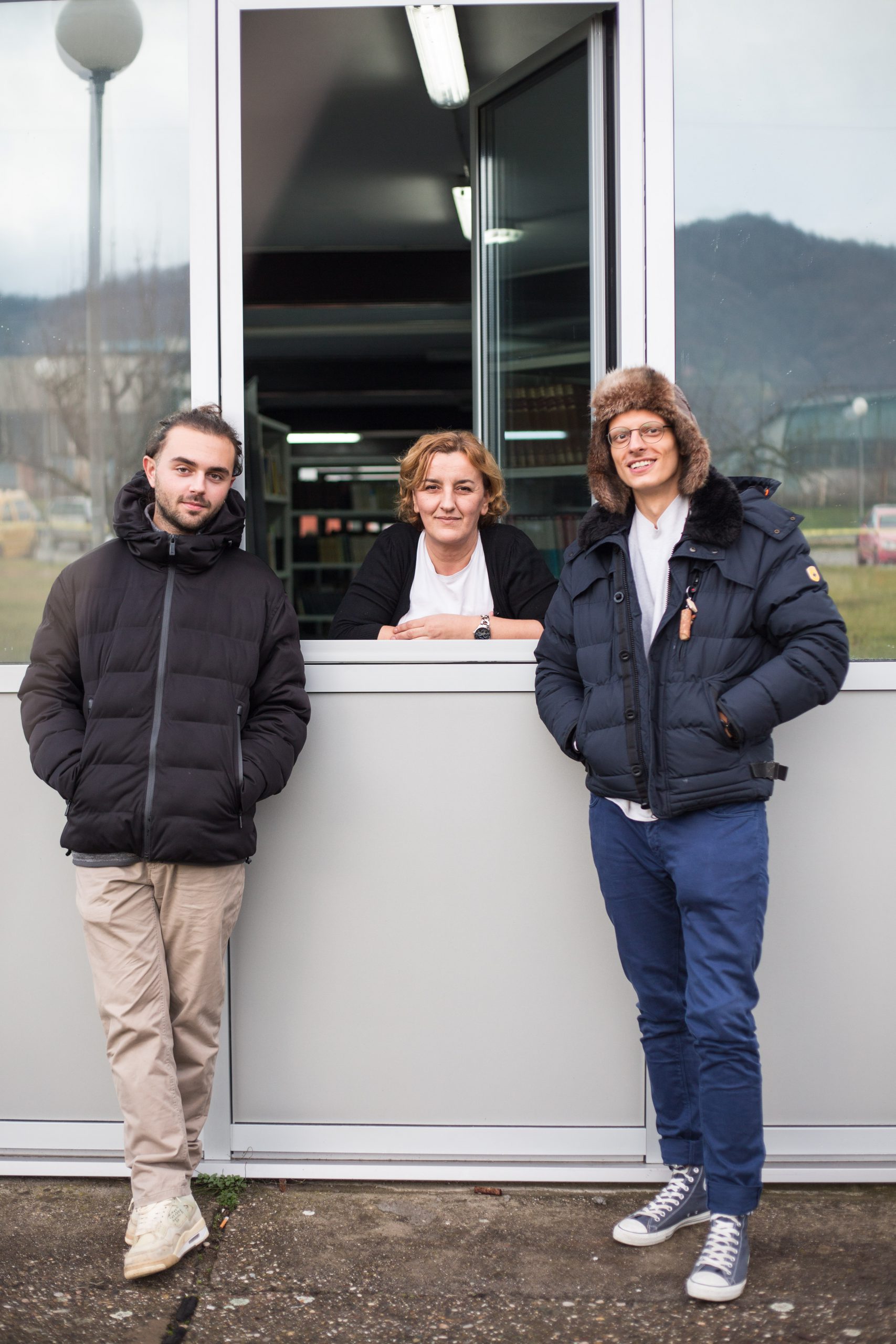
Initially, the support of the two very first volunteers from abroad was a surprise to everyone at the Memorial Center: “We were all astonished that they came from a safe and privileged world and wanted to live here.” Now Begić (centre) hopes to cooperate with Austrian Service Abroad on a long term basis. Photo: Martin Zinggl / tippingpoint.net
Initially, the support of the two very first volunteers from abroad was a surprise to everyone at the Memorial Center: “We were all astonished that they came from a safe and privileged world and wanted to live here.” Now Begić hopes to cooperate with Austrian Service Abroad on a long term basis. Initiator Miskić would like that too: “When I come to visit in ten years’ time, I’d love peace servants to be still working here. Who knows, there might be even some from Serbia.”
Miskić and Petrović are staring spellbound at the screens of their computers at the Memorial Center in Potočari, listening to interviews with survivors. “At times I dream about the war afterwards and find myself running away from the Serbs in the forest,” says Miskić. Both have become accustomed to horror stories; they also take an interest in politics and engage in religion – three topics that you cannot get around in Bosnia-Herzegovina.
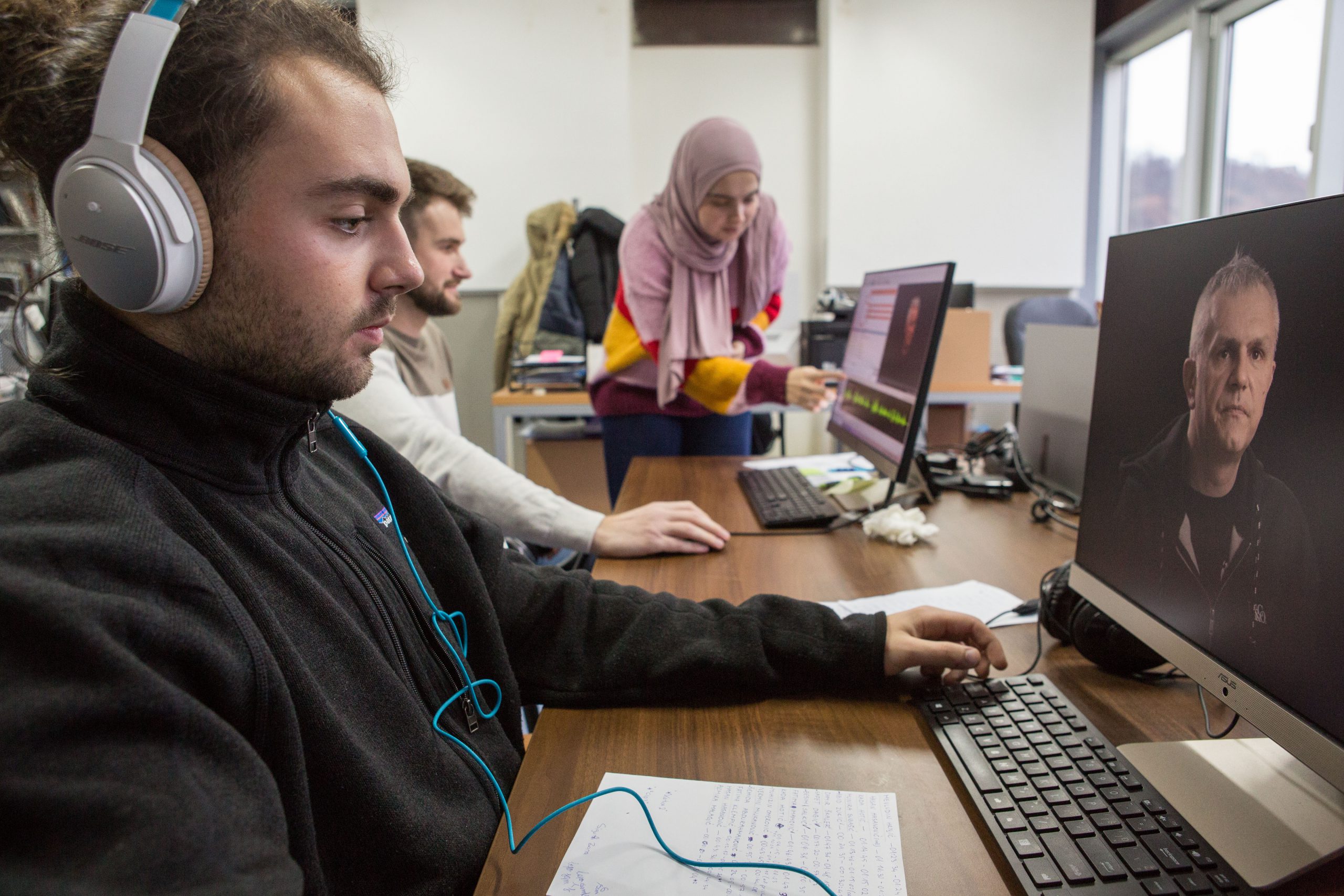
At the Memorial Center in Potočari, Dennis Miskić transcribes interviews with survivors. One of the tasks for the two peace servants. Photo: Martin Zinggl / tippingpoint.net
Miskić spontaneously cancelled his assignment in Dayton to extend his stay in Srebrenica. “I came to Bosnia to get to know my parents’ roots,” he says. “Now I’m resuming the life they could have had here, getting to know the culture properly. Now I think, talk and eat like a Bosnian. When will I get another chance of dealing with my history for ten months? Srebrenica is a topic that every Bosnian should know about.”
Petrović struggles with the language barrier. He’s looking at three sheets of paper filled with terms that are foreign to him in every sense: nišan – tombstone, halaliti – forgive, ćilim – prayer rug, rahmetli – deceased. Loan words from Turkish and Arabic, terms from Islam. He is an idealist who would like to do more but lacks the courage. Yet, he is not afraid of the Bosnians’ reactions but of those of his own people. “I’ll manage,” says Petrović, “I want to be an idol after all. That’s not that easy, you know.” But what is easy in Srebrenica?
All of a sudden, they receive news of the discovery of a new mass grave, the first since 2016. At least ten bodies in it are victims from Srebrenica. The Memorial Center team is sobered by the news; it is the ninetieth grave so far. What surprises them is the location: 200 kilometres from Srebrenica – such a great distance is new even to Begić, who is, however, not surprised that victims are still being found. More than a thousand people are still considered missing. It is important to remember them. “We can’t build a new life here until all the dead have returned home,” she says.
Original in German. First published in the 02/2022 issue of the monthly DATUM – Seiten der Zeit in February 2022. The research and production of this article has been realisied with funds of ERSTE Foundation.
Translated into English by Barbara Maya.
This text is protected by copyright: © Martin Zinggl / tippingpoint.net. If you are interested in republication, please contact the editorial team. Copyright information on pictures, graphics and videos are noted directly at the illustrations. Cover picture: Aleksandar Petrović and Dennis Miskić at the memorial site Potočari. Photo: Martin Zinggl / tippingpoint.net